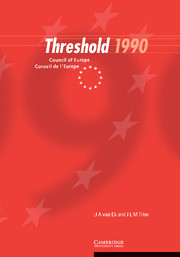Book contents
- Frontmatter
- Contents
- Preface
- Introduction
- 1 The objective: levels of specificity
- 2 The objective: general characterisation
- 3 The objective: extended characterisation
- 4 The objective: components of the specification
- 5 Language functions
- 6 General notions
- 7 Specific notions
- 8 Verbal exchange patterns
- 9 Dealing with texts: reading and listening
- 10 Writing
- 11 Sociocultural competence
- 12 Compensation strategies
- 13 Learning to learn
- 14 Degree of skill
- APPENDICES
4 - The objective: components of the specification
Published online by Cambridge University Press: 26 February 2010
- Frontmatter
- Contents
- Preface
- Introduction
- 1 The objective: levels of specificity
- 2 The objective: general characterisation
- 3 The objective: extended characterisation
- 4 The objective: components of the specification
- 5 Language functions
- 6 General notions
- 7 Specific notions
- 8 Verbal exchange patterns
- 9 Dealing with texts: reading and listening
- 10 Writing
- 11 Sociocultural competence
- 12 Compensation strategies
- 13 Learning to learn
- 14 Degree of skill
- APPENDICES
Summary
A communicative approach aims to enable the learners to use a foreign language for their own purposes. What these purposes are, depends on the personality, the circumstances, the needs and interests of the learners themselves. They are never fully predictable, but, starting from a particular target group, however heterogeneous it may be, we can make an attempt to identify those things that all of them are at least very likely to need or wish to be able to do in the foreign language. In order to do this in any useful way we have to try and determine in what situations they are most likely to use the foreign language, what roles they will play in these situations, and what matters they are most likely to have to be able to deal with in the foreign language. Determining all this – especially if we want to arrive at a fairly detailed description – is, in a way, a matter of guesswork. However, we can make at least better educated guesses if we make use of our collective experience, our knowledge of the world, and of whatever amount of consensus would appear to have been – explicitly or implicitly – achieved. In fact, the information on this that is available now is by no means negligible. It may be found in numerous studies that have appeared since the Threshold Level was originally published, and it is to be found in the choices made in those course materials with a communicative orientation that have been produced in the last 20 years or so.
- Type
- Chapter
- Information
- Threshold 1990 , pp. 22 - 26Publisher: Cambridge University PressPrint publication year: 1998

